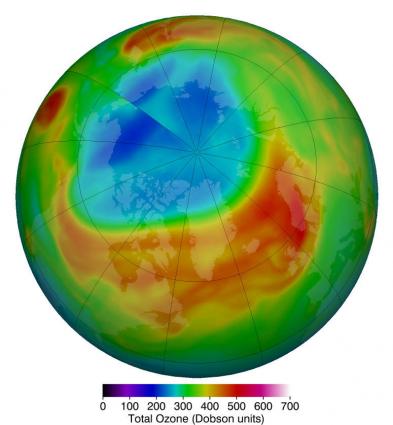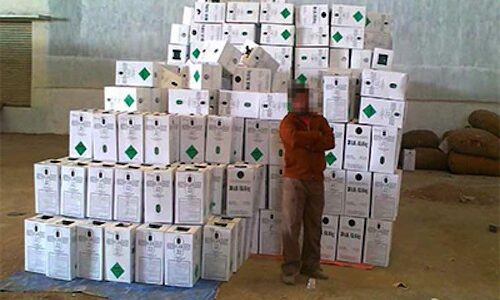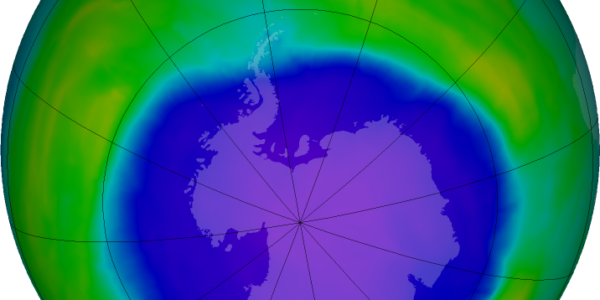Extreme weather, CFC damage result in record Arctic ozone depletion
- PostedPublished 17 July 2020
The World Meteorological Organisation (WMO) has reported that ozone layer depletion reached record levels over large parts of the Arctic in spring.
Monitored ozone levels over the Arctic in March are typically at least 240 Dobson Units (DU) – with a DU representing a 0.01mm-thick layer of pure ozone at standard temperature and pressure (STP). Generally, according to NASA, the average ozone layer measures 300 DU, equivalent to a thickness of 3mm.
However, a record low of 220 DU was reported for March 2020, with downward peaks of just 205 DU. Such numbers are considered “ozone hole levels”, resulting in a weakened natural sunscreen and causing increases in ultraviolet (UV) radiation in the affected areas; similarly strong Arctic ozone depletion was observed back in spring 2011, which caused a 60 per cent increase in the UV index in the Canadian Arctic – and an even higher increase over Northern Europe.
Fortunately, as environmental conditions changed, an influx of ozone-rich air from the lower atmosphere served to close the ozone hole in April. Nevertheless, the event demonstrated how occasional large depletions are still possible despite the ongoing recovery of the ozone layer.

The WMO has attributed these record low depletion levels to two distinct factors. The first is a culmination of climate conditions that promote the formation of ozone holes, including sustained extremely cold temperatures in the atmosphere and a lack of “wave” events – which drive masses of air through the atmosphere, bringing in ozone-rich air from other regions.
Unsurprisingly, the second factor was the continued presence of ozone-depleting chemicals in the atmosphere. Many have long been removed from use by the ozone-protecting Montreal Protocol but those already emitted often remain in the atmosphere for decades, resulting in ongoing damage.
However, atmospheric monitoring has detected unexpected increases in ozone-harming chemicals such as chlorofluorocarbons (CFCs) – highlighting the need for ongoing monitoring, assessment and regulation.
“The Arctic stratosphere continues to be vulnerable to ozone-depleting substances linked to human activities,” said WMO secretary-general Petteri Taalas. “The 2020 ozone loss shows that we have to remain vigilant and maintain continuous observations.”
Without agreements such as the Montreal Protocol, the ozone depletion in 2020 would have no doubt been far worse – and figures from the WMO and UN Environment Programme show that areas of the ozone layer have recovered at 1 per cent to 3 per cent per decade since 2000. As a result, if the projected rates remain unchanged, the entirety of the ozone layer should heal completely by 2060.
Meanwhile, on the other side of the planet
Over in Antarctica, the weather has instead played in favour of the ozone layer – resulting in the smallest ozone hole on record.
The ozone hole, which was first observed over Antarctica in 1982, typically extends to 21 million square kilometres – almost three times the surface area of Australia.
This expansion starts in September and continues through to mid-October and is driven by a range of processes, including the sun catalysing with man-made compounds in the atmosphere.
These destructive chemicals then adhere to cloud particles, resulting in reactions that destroy ozone molecules.

However, according to scientists at NASA and the US National Oceanic and Atmospheric Administration, the hole reached just 14.5 million square kilometres in early September 2019 – and then shrank to less than 10 million square kilometres for the rest of the month and remained unchanged.
This was due to warmer temperatures, which reduced cloud formation and minimised the ozone-depleting process.
“It’s great news for ozone in the Southern Hemisphere,” said Paul Newman, chief scientist for Earth Sciences at NASA’s Goddard Space Flight Center in Greenbelt, Maryland.
“But it’s important to recognise that what we’re seeing this year is due to warmer stratospheric temperatures – it’s not a sign that atmospheric ozone is suddenly on a fast track to recovery.”
Alarm at new ODS emissions
Global production of CFC-11 and CFC-12 ended in 2010 due to the Montreal Protocol, which sought to eliminate emissions of ozone-depleting substances.
Emissions of both, however, began to rise again in 2013. Illegal production in China was initially deemed the cause but, even after the government acted to reduce output, the volume of emissions remained larger than expected.
Researchers at the US Massachusetts Institute of Technology (MIT) have now concluded that the majority of emissions are from “banks” of old CFCs.
These banks consist of old hardware such as CFC-charged refrigeration equipment, as well as insulating materials produced using CFCs.
Previously, these caches of stored CFCs were deemed small and left untouched.
Now, new analysis methods have proven the banks are far larger than previously estimated – and account for much of the estimated emissions, aside from the rise in CFC-11 emissions after 2012.
MIT researchers state that, if left unchecked, the CFCs from these banks could delay ozone recovery by six years.
The emitted CO2 equivalents would also match the reduction planned by the European Union as part of the climate-protecting Paris Agreement, making its efforts somewhat moot.
Sizable emissions of CFC-113, which is still used in chemical production, have also been identified by MIT. It is as harmful as CFC-11, so poses a significant problem.
China moves to limit HFC, ODS emissions
A new national plan implemented by the Chinese government aims to reduce HFC emissions, although China is yet to officially ratify the Kigali Amendment to the Montreal Protocol that will phase down high-GWP products globally.
Measures in the new plan include increased penalties for illegal HFC production and sales, rewards for violation reports and improved monitoring and detection technologies. In addition, a quota system will be introduced to phase down HFC production and consumption.
Also, as part of a crackdown on rising CFC-11 emissions, the head of a polyurethane foam insulation manufacturer has been jailed in what is China’s first successful court case concerning the illegal use of ozone-depleting substances.
Tackling CFC banks vital to Montreal Protocol
A new study indicates that “banks” of CFC-11 and CFC-12, both harmful ozone-depleting chemicals, are far larger than previously modelled.
As discussed on Page 19 of this issue, these chlorofluorocarbons (CFC) banks are thought to be responsible for the majority of the estimated CFC-11 and CFC-12 emissions in the recent years.
The study, which was carried out by researchers at the US Massachusetts Institute of Technology, says these large banks could delay Antarctic ozone recovery by six years – and result in the emission of nine billion tonnes of CO2-equivalent.
All nations effectively agreed to phase out production of these CFCs by 2010, as part of the ozone-protecting Montreal Protocol.
CFCs were otherwise commonly used in refrigeration, air conditioning and foam-blowing production – and this ‘stored’ source of CFC can escape to atmosphere over time.
Problematically, the study from MIT researchers demonstrates that these banks are substantially larger than recent assessments had suggested.
This is partially attributed to the underreporting of production, leading to a disparity between on-paper and real-world figures.
The study highlights that it is essential to understand and tackle these banks to avoid future issues.
Reportedly, recovery and destruction of these banks has been considered by policymakers.
Acting sooner, rather than later, could safeguard the efforts of the Montreal Protocol and enhance ozone recovery.
- CategoriesIn SightGlass
- TagsCFCs, hcfcs, Montreal Protocol, ozone, ozone layer, SightGlass News Issue 20




